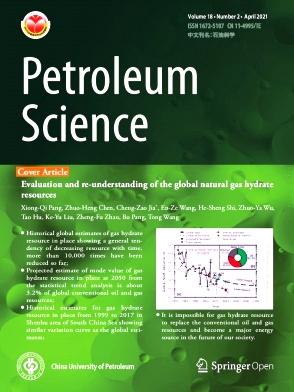Evaluation of micro-dispersion on oil recovery during low-salinity water-alternating-CO2 processes in sandstone cores: An integrated experimental approach
IF 6
1区 工程技术
Q2 ENERGY & FUELS
引用次数: 0
Abstract
Low-salinity water (LSW) and CO2 could be combined to perform better in a hydrocarbon reservoir due to their synergistic advantages for enhanced oil recovery (EOR); however, its microscopic recovery mechanisms have not been well understood due to the nature of these two fluids and their physical reactions in the presence of reservoir fluids and porous media. In this work, well-designed and integrated experiments have been performed for the first time to characterize the in-situ formation of micro-dispersions and identify their EOR roles during a LSW-alternating-CO2 (CO2-LSWAG) process under various conditions. Firstly, by measuring water concentration and performing the Fourier transform infrared spectroscopy (FT-IR) analysis, the in-situ formation of micro-dispersions induced by polar and acidic materials was identified. Then, displacement experiments combining with nuclear magnetic resonance (NMR) analysis were performed with two crude oil samples, during which wettability, interfacial tension (IFT), CO2 dissolution, and CO2 diffusion were quantified. During a CO2-LSWAG process, the in-situ formed micro-dispersions dictate the oil recovery, while the presence of clay minerals, electrical double-layer (EDL) expansion and multiple ion exchange (MIE) are found to contribute less. Such formed micro-dispersions are induced by CO2 via diffusion to mobilize the CO2-diluted oil, alter the rock wettability towards more water-wet, and minimize the density contrast between crude oil and water.
求助全文
约1分钟内获得全文
求助全文
来源期刊

Petroleum Science
地学-地球化学与地球物理
CiteScore
7.70
自引率
16.10%
发文量
311
审稿时长
63 days
期刊介绍:
Petroleum Science is the only English journal in China on petroleum science and technology that is intended for professionals engaged in petroleum science research and technical applications all over the world, as well as the managerial personnel of oil companies. It covers petroleum geology, petroleum geophysics, petroleum engineering, petrochemistry & chemical engineering, petroleum mechanics, and economic management. It aims to introduce the latest results in oil industry research in China, promote cooperation in petroleum science research between China and the rest of the world, and build a bridge for scientific communication between China and the world.
 求助内容:
求助内容: 应助结果提醒方式:
应助结果提醒方式:


